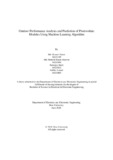| dc.contributor.advisor | Rahman, Md. Mosaddequr | |
| dc.contributor.author | Islam, Md. Kamrul | |
| dc.contributor.author | Shawon, Md. Mehedi Hasan | |
| dc.contributor.author | Akter, Sumaiya | |
| dc.contributor.author | Ahmed, Sabbir | |
| dc.date.accessioned | 2021-12-12T09:30:13Z | |
| dc.date.available | 2021-12-12T09:30:13Z | |
| dc.date.copyright | 2020 | |
| dc.date.issued | 2020-06 | |
| dc.identifier.other | ID 16121105 | |
| dc.identifier.other | ID 16221056 | |
| dc.identifier.other | ID 16321012 | |
| dc.identifier.other | ID 16321003 | |
| dc.identifier.uri | http://hdl.handle.net/10361/15727 | |
| dc.description | This thesis is submitted in partial fulfillment of the requirements for the degree of Bachelor of Science in Electrical and Electronic Engineering, 2020. | en_US |
| dc.description | Cataloged from PDF version of thesis. | |
| dc.description | Includes bibliographical references (pages 123-127). | |
| dc.description.abstract | The objective of this study is to inspect the performance of the photovoltaic (PV) modules in different environmental conditions and to apply a machine learning algorithm for prediction analysis. Photovoltaic modules are very sensitive to weather conditions such as cloudy, rainy, sunny days. Hence, weather parameters, for example, Irradiance, temperature, humidity, air-pressure have an impact on PV modules performance. Two Mono-Silicon PV modules have been set up on a seven-storied building in Gabtoli, Dhaka to collect the environmental data. Among two PV modules, one module is cleaned regularly and the other module is not cleaned to observe the dust effect on PV modules performance. A weather station is designed using Raspberry Pi 3B+ modules where different sensors are used to collect both modules short circuit current as well as temperature, humidity, wind speed and air-pressure data. The data of the PV modules and the environmental parameters are being collected from the end of October 2019. Data from November 2019 to February 2020, are used to analyze the performance of these PV modules. Furthermore, a theoretical calculation is done to calculate the solar irradiance (Ideal and Experimental), PV modules power output and energy output. Moreover, one of the segments of machine learning that is neural network which is used to train the model based on the collected data so that a fruitful prediction can be done. An algorithm named Multi-Layer Perceptron (MLP) using Artificial Neural Network has been developed which can provide us with the PV modules energy output of a particular day or time based on the training dataset. The accuracy of the output depends on the training dataset but most importantly it depends on the correct parameters which have been shown in this study. | en_US |
| dc.description.statementofresponsibility | Md. Kamrul Islam | |
| dc.description.statementofresponsibility | Md. Mehedi Hasan Shawon | |
| dc.description.statementofresponsibility | Sumaiya Akter | |
| dc.description.statementofresponsibility | Sabbir Ahmed | |
| dc.format.extent | 141 pages | |
| dc.language.iso | en | en_US |
| dc.publisher | Brac University | en_US |
| dc.rights | Brac University theses are protected by copyright. They may be viewed from this source for any purpose, but reproduction or distribution in any format is prohibited without written permission. | |
| dc.subject | Short circuit current | en_US |
| dc.subject | Temperature | en_US |
| dc.subject | Wind speed | en_US |
| dc.subject | Humidity | en_US |
| dc.subject | Solar irradiance | en_US |
| dc.subject | Cumulative electrical energy | en_US |
| dc.subject.lcsh | Wind power. | |
| dc.subject.lcsh | Machine learning | |
| dc.subject.lcsh | Photovoltaic power systems. | |
| dc.title | Outdoor performance analysis and prediction of photovoltaic modules using machine learning algorithm | en_US |
| dc.type | Thesis | en_US |
| dc.contributor.department | Department of Electrical and Electronic Engineering, Brac University | |
| dc.description.degree | B. Electrical and Electronic Engineering | |

